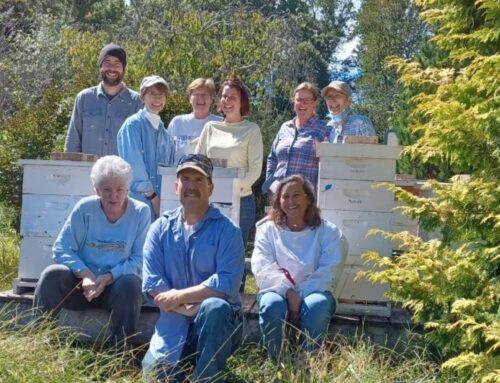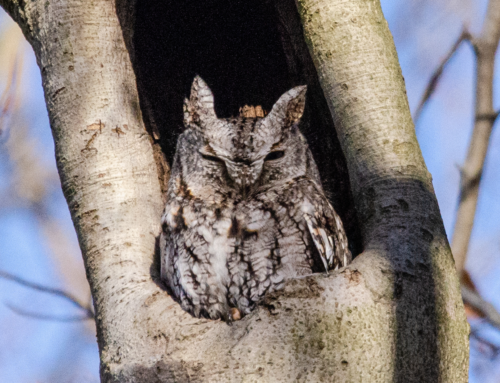The relationship between humans and bees commonly intersects through the practice of beekeeping. Honey bees, in this case “European” honey bees, are “livestock” that have been domesticated over hundreds of years, perhaps thousands. As with dairy cows, pigs, sheep, dogs and cats, humans long ago recognized the value in cultivating a wild creature – a flying insect. Thus, over a long period of time, humans modified that creature into a form where we symbiotically rely on each other in very profound ways.
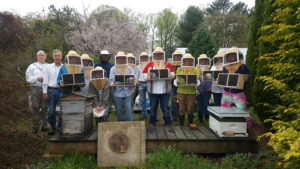
Let’s face it – early on, humans discovered the sweet liquid that we know as honey and sought it out. Prehistoric cave and rock paintings document honey “hunting” by our ancestors in many parts of the world. Sure, they got stung a few times in their early quest for a sugar fix. But clearly they didn’t get stung enough to deter them from seeking out the honey bee and its hive – the benefit of the honey outweighed the cost of a few stings! Eventually, as this one-sided relationship evolved, some humans observed that some bees don’t sting as much as others, and some of those bees produced a lot of honey – “Gee! Wouldn’t it be great if I could just move this dead tree trunk where they live right behind my house?” Eventually this evolved into, “Gee, maybe if I could cut this dead tree trunk into three pieces, I could get three hives behind my house!” And so on – you get the (overly) simplified picture…
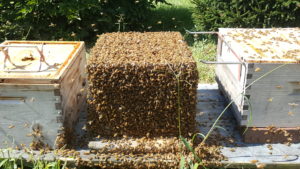
Over time, chunks of wood were replaced with upside down flower pots, and those pots were replaced by a woven material (still like an upside down flower pot) and now you had a portable, inexpensive way to keep your bees close by and safe – I present to you the Skep! Now we are on a roll, we have bees, we have lots of honey, and even wax, propolis (bee glue), and pollen (bee bread). But wait! As always there is a rub. It seems like a lot of other creatures like honey too. Now a big part of raising bees, like raising cattle, chickens, sheep, etc., is taking care of and protecting them. The bees are now dependent upon humans for protection, just as we humans are hooked on their honey, wax and propolis. We are also finding that honey has antibacterial properties and can be used to dress wounds and our gardens are producing more food. We humans have now become as dependent upon these little animals as they have on us.
Flash forward to the 1600’s. European settlers introduced the European honey bee to North America. Native Americans called them “White Man’s Flies”. Flash forward again to the 1800’s, and Philly native Lorenzo Langstroth created the single greatest worldwide innovation in beekeeping called the “Langstroth Hive”. The Langstroth Hive was revolutionary in that it took what was originally a pretty brutal beekeeping practice and made it entirely gentle, humane, and above all, EFFICIENT! In my opinion, the Langstroth Hive is the “better mousetrap” and will never be supplanted for its simplicity and efficiency. Now beekeeping had all the elements needed to begin expanding, growing and monetizing on an industrial scale.
Today, eighty percent of what you buy in the grocery store is impacted by honey bees, mostly through pollination. Eighty to ninety percent of all commercial honey bee colonies spend January and February in California, pollinating almonds. A colony is required for nearly every acre of almonds, and there aren’t enough colonies to do the pollination. As a result, a colony that could be contracted to pollinate almonds for $40 in 1996 now fetches $200+. Entire flatbed trucks full of bees get stolen, mites and mysterious “colony collapse” decimate honey bee populations, and much of the honey available in stores is imported and suspected to be counterfeit (illegal honey from China that has been “laundered” for sale in the US). What’s going on? Are honey bees the canary in the coal mine?
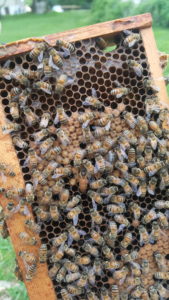
Unfortunately, I don’t have any answers, just opinions that I won’t share here. What I will say is that beekeeping and honey bees are far from doomed – just ask any of the dozens of beekeepers who have graduated from Tyler’s “Hive Sponsorship” program, now in its sixth season. Here we have trained men and women, young and old, engineers and artists, to embrace what is the most fascinating of creatures – the simple honey bee. This fall, look for our honey in the visitor center or at the plant sale. Ask about our program, now enrolling for spring 2021, or take a walk by our modest apiary, next to the Horticulture Maintenance Building.




